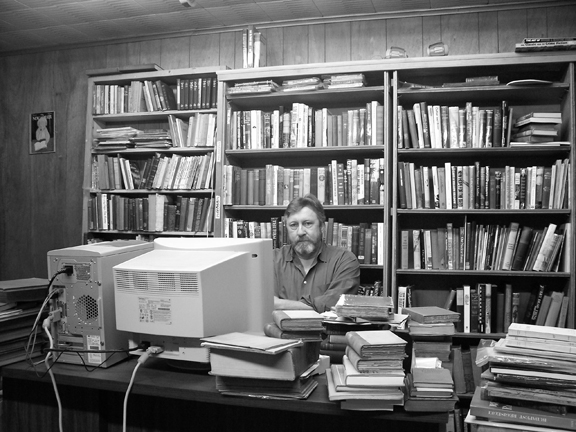By Frank Dougherty
A former movie house that began screening Hollywood silent films 93 years ago for Port Richmond residents is now headquarters for one of the largest and, from an Irish viewpoint, most interesting used bookstores in Philadelphia.
“I think we have about 100,000 books here along with stacks of old magazines, newspapers, theater programs, movie posters,” explained Greg Gillespie, the operator Port Richmond Books.
“You name it, we probably have it. And we also can throw in a little hardware on the side,” quipped the 58-year-old Gillespie. The shop is located at 3037 Richmond Street.
For Philadelphians of a certain age, walking into Port Richmond Books is guaranteed to trigger an immediate response from one’s ol’ factory nerves. The place smells like Leary’s, the classic used bookstore on a dead-end alley in Center City that closed in 1968.
There are books on history, geography, biographies, religion, weather, Mafia bosses, privates and generals, mystery sleuths, saints and sinners, doctors, lawyers, and, yep, you guessed it, Indian chiefs!
The business is eclectic in structure, varied in selection, with books drawn from sources around the city, around the country, around the world.
There are books by C.S. Lewis, James Bond, Bishop Fulton J. Sheen, Philip Roth, Zane Grey, Jack McPhaul, and even a book written by the late cartoonist Walt Kelly, demanding, “Equal Time for Pogo.” But the centerpiece of the business is an aisle Gillespie has nicknamed Irish Row.
It has no relationship with the original Irish Row, a string of Irish-American saloons along Arkansas Avenue in Atlantic City, popular with seashore visitors in the years just after World War II.
Irish Row here is an aisle 20 feet long and eight feet high with more than 1,500 books with native Irish and Irish-American themes. States of Ireland by Conor Cruise O’Brien is in the stacks. So is Thomas N. Coffey’s history on the 1916 Easter Uprising. Pete Hamill, Frank Harris and J. P. Donleavy are represented, and James Joyce’s Ulysses has a prominent place in the stacks.
“One of the most intriguing books (here) is this slim volume in old Irish, dating back to the 1840s, hand lettered in pen and ink, with a small spattering of English,” explained Gillespie as he gently deposited it into the extended hands of a visitor. “It was brought to Philadelphia by an immigrant, now only known to history,” he added. This printed inventory, however, has unusual neighbors. It shares spaces with thousands of pieces of assorted hardware. “When my mentor, Deen Kogan, bought the building, it had been Fisher’s hardware warehouse,” explained Gillespie. “Deen bought the place lock, stock and barrel. So we now have row after row of books, thousands and thousands of volumes, vying for space with row after row of plumbing fixtures, tools and fasteners.” An ardent lover of books, Kogan is the owner and operator of Society Hill Playhouse, a Philadelphia showcase for the past 46 years of plays and productions with Irish themes. “My late husband, Jay, had a great love of books and literature, mysteries and detective novels in particular. There are 30,000 books in Jay’s collection now in storage at Port Richmond Books,” explained Kogan.
Port Richmond Books unofficially opened in December 2005, but few people were on hand for such an auspicious beginning. “We had no heat, so we waited until April to make it official with a crowd of family and friends,” said Gillespie. An Overbrook resident, Greg Gillespie and his wife, Meg, are the parents of 24-year-old Anne, and 19-year-old Michael. Meg operates her own catering firm, Staffing Associates. “If it wasn’t for Meg, we would all be eating sticks. She’s absolutely superb,’ said Gillespie. The Port Richmond Books building opened in 1913 as a silent movie house. Designed by architect Allen Wilson, it was the place to comfortably enjoy the flickers in a river ward movie palace with 1,026 seats.
The Richmond movie house was an American creation at a point in time when the country’s emerging entertainment industry was developing as rapidly as its industrial base and economic power. The building has retained its painted concrete facade with its two upper balustrades, placed stage right and left. At the roof line, a granite block identifies the building as the “Richmond.” When the theater opened 93 years ago, “Wall scones with shades provided illumination along (the) walls lined with framed sections of fabric,” according to the late Philadelphia theater historian Irvin R. Glazer. “A Moeller organ provided the music and five aisles created easy access in the spacious auditorium which was 60 feet wide, and 116 feet long,” added Glazer. The cleats that held the seats in place are still visible on the auditorium floor. And what has become of that Moeller organ? Well, it’s still in the old auditorium, crushed under a load of debris, its bellows and pipes secured in a nearby storeroom. The projection room is intact, too. A former environmental health inspector for the City Of Philadelphia, Gillespie’s love of books was developed through a fondness for reading while still a child. “I grew up collecting books. Then I met Jay Kogan. He got me interested in attending book fairs, which, by extension, led to a life of buying, selling and trading books,” said Gillespie.
As late as 1940, the Richmond Theater retained its advertising drop curtain which carried paid promotion and marketing notices.
Following the introduction of the talkies, the Richmond offered second and third run double-feature films. Its silver screen began to lose its luster to competition from television, with the end coming in the early 1950s.
Information for this story was drawn from: Philadelphia Theaters A-Z: A Comprehensive Record of 813 Theaters Constructed Since 1742. Complied by the late Irvin R. Glazer, it was published by Greenwood Press.

